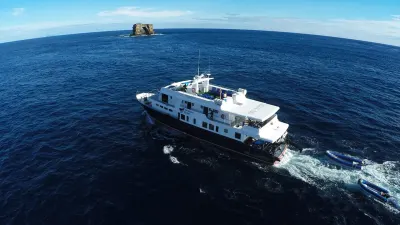As reported by the Manta Trust, a recent study has confirmed Ecuador’s manta population to be the largest on earth.
Incredibly, scientists involved in the study identified a distinct population of oceanic manta rays off the coast of Ecuador that is more than ten times larger than any other known subpopulation of the species.
The research, published in the journal Marine Ecology Progress Series, was led by Fundación Megafauna Marina del Ecuador, a conservation organisation based in Ecuador, in collaboration with The Manta Trust, the Marine Megafauna Foundation, and the Ocean Ecology Lab at OSU’s Marine Mammal Institute.
According to Joshua Stewart, an assistant professor with the Marine Mammal Institute in OSU’s College of Agricultural Sciences and a co-author of the paper, these findings indicate that, while other populations of oceanic manta rays are typically small and therefore extremely vulnerable to human impacts, this population is large and potentially quite healthy.
“It’s clear that something different is happening here,” Stewart said. “This is a rare story of ocean optimism. In other regions, we typically have population estimates of 1,000 to 2,000 animals, which makes this species very sensitive. In this area, we’ve estimated that the population is over 22,000 mantas, which is unprecedented.”
The rays tend to straddle the border between Ecuador and Peru, aggregating around Ecuador’s Isla de la Plata between August and September each year. Understandably, Isla de la Plata has become a popular diving destination, with many visiting divers taking numerous photographs of the animals, providing researchers with a trove of data.
“Many of the photos used in our study were contributed by recreational divers who became citizen scientists when they snapped photos of manta rays,” says Kanina Harty of The Manta Trust, lead author of the study. “We get a huge amount of information about each animal just from these photographs.”
Combining data collected through their own observations and images from recreational scuba divers taken between 2005 and 2018, researchers were able to identify more than 2,800 individual rays and estimate a total population of more than 22,000.
“That is significantly larger than what we’ve seen in oceanic manta ray populations elsewhere,” said Guy Stevens, Chief Executive and Founder of The Manta Trust. “This is by far the largest population that we know of.”
The study’s authors believe that manta rays are likely drawn to the area due to the availability of food, with upwellings of cold water providing an abundance of nutrients.
“This work solidifies Isla de la Plata, and Ecuador more broadly, as a globally important hotspot for this endangered species,” said Michel Guerrero of Fundación Megafauna Marina del Ecuador. “While this population may be healthy thanks in part to its large size, it is essential that we take the necessary steps to protect it and prevent the declines that many other manta ray populations have faced.”
While capturing manta rays in fisheries has been illegal in Ecuador since 2010, and since 2016 in neighbouring Peru, the species likely still faces threats from fishing activity. There were 563 manta rays identified in the study with visible injuries, and more than half of those were either entangled in fishing gear or showed scarring from a past entanglement.
Stewart suggests that continued monitoring of the population is needed to understand how human activity and climate change may affect food availability, distribution and overall population health.
“While there is good news about this population, it is a cautionary tale,” he said. “Manta rays appear to be sensitive to environmental changes such as changes to ocean temperatures and food availability. They will likely be impacted by a warming climate if upwelling strength and the location and abundance of their food changes alongside ocean temperatures.”
Co-authors of the study are Kanina Harty and Guy Stevens of The Manta Trust; Michel Guerrero and Anna Knochel of the Fundación Megafauna Marina del Ecuador; Andrea Marshall and Katherine Burgess of the Marine Megafauna Foundation; and Joshua Stewart of Oregon State University.
Ready to dive the Galapagos Islands?
Speak to the travel team today

ZuBlu is the leading dive travel agency to search, compare and book scuba diving travel worldwide.






